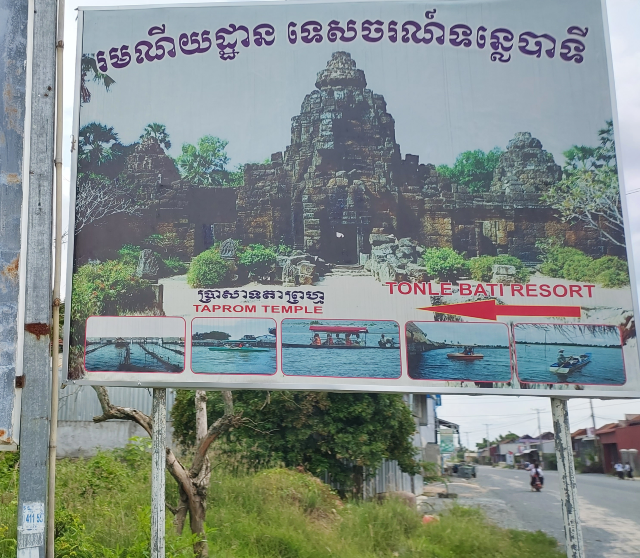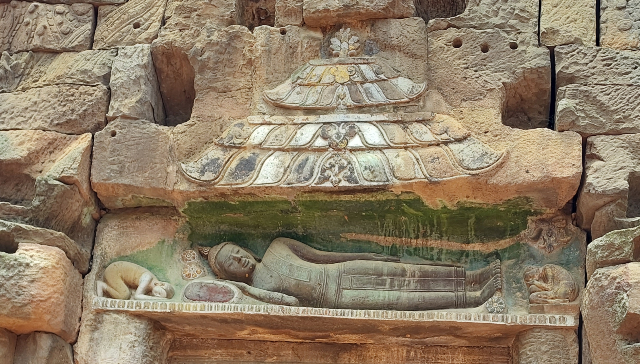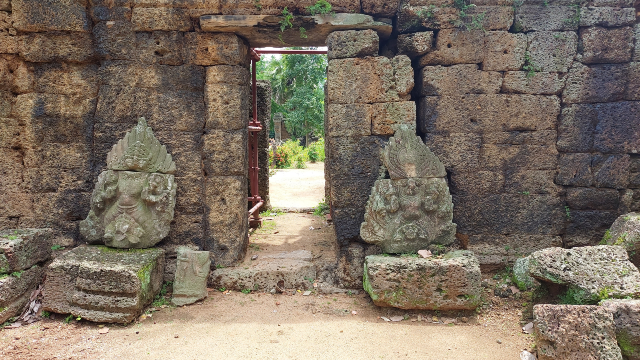Ta Prohm near Tonle Bati lake is situated 30 kms from Phnom Penh. Incidentally, there is a Ta Prohm with the same name in Seam Reap. Both these temples belong to the same Angkorian period. I found both the temples very different from each other. Maybe, the overgrown trees and vines around the temple in Ta Prohm, Siem Reap gives a different impression. I am talking about the famous Ta Prohm with overgrown trees, Ta Prohm, Siem Reap

- the temple was named Sri Suryaparvata or Suryagiri (mountain of sun, for both names in Sanskrit)
- the earlier temple was a place of worship with Hindu deities, built in the 6th century
- the temple was dedicated to both Shiva and Vishnu. No doubt you see many Garuda figures here.
- along with Vishnu, Shiva was also worshiped here. The presence of Shiva
Yoni confirms this. Harihara meaning the presence of both deities.
Hari (Vishnu), Hara (Shiva). Harihara were reigning deities in Angkor at
one time also.
- Ta Prohm is placed on the site of the old Hindu temple. It was built during the reign of King Jayavarman VII(1181-1201) in the late 12th or early 13th century.
- the structure is made of brick and laterite. It must have been decorated with relief earlier, most of them on the ground now.
- Jayavarman converted to Buddhism and followed the Mahayana stream.
Layout of temple:
The layout of the temple is very simple. There is an outer wall with four entrances, only two can be seen now. The outermost wall is almost non-existent, visible only in small places. Entrance to temple complex is through two gopuras, one on east and the other on west.
A inner gallery with four gopuras surrounds the central sanctuary. Laterite has been used for building walls but sandstone has been used in pediments, lintels, relief as this gave good results after sculpting.
The main tower or sanctuary stands in the center.
A covered cloister surrounds the central tower connecting to gopuras in four directions.
a beautiful wat nearby
part of the crumbling outer wall
buying flowers
As soon as tourists arrive at the temple, girls run to sell lotus flowers and joss sticks which are offered at temple inside.
east entrance gate
What now remains of the gate are huge laterite blocks.
view of east entrance gate from inside
east gopura with north gopura on left and south gopura on the right side
small shrine near the entrance
relief on ground which once decorated either the temple or the entrance gopura
Ponds on both sides of temple
Srahs and barays were reservoirs. They served both for agricultural and religious purposes. Many temples in Siem Reap were built near huge barays.
Two relief are seen on either side of east entrance gopura.
relief probably depicting a scene from Mahabharata
The relief shows Lord Krishna pulling chariot for Arjuna during the battle.
This relief shows Samudra manthan, Churning of the Ocean
An image stands in the center
rear view, missing pediment on top of gopura
Central Sanctuary:
The enclosure surrounding central tower is 42 meters long and 36 meters wide. The laterite sanctuary in the center is decorated with stunning relief of apsaras, praying ascetics, Garuda. Some of them are seen on the ground now.
reclining Buddha on pediment
Sandstone carving of reclining Buddha at entrance. Some colors are still visible. I am sure it must have looked beautiful earlier.
The sanctuary has 5 chambers one behind the other.
East facing, 13th century standing Buddha image in the 1st chamber
Past the first chamber is another image in the second chamber
On the side is seen a Shiva yoni. Combined worship of Vishnu (Hari) and Shiva (Hara) was worshiped. Maybe, an image of Vishnu also stood here.
view from southern entrance
3rd , 4th and 5th chamber as visible from the 2nd chamber
4th chamber, a statue once stood here
5th chamber
entrance on south side of central tower
this is the entrance to 2nd chamber
Vishnu with four arms on tympanum
meditating Shiva on lintel
ascetics on doorjamb
south gopura
Here, Vishnu or Noreay (Narayan) has 6 arms each holding a weapon. A row of praying ascetics sit below him
doorjamb at entrance

a relief panel on ground in front of north entrance to temple
Other relief structures outside the central tower:
The walls of temple are richly decorated and there is hardly any place left which I could not think of taking a picture of.
the relief work is so similar to those at Angkor Wat

work on sides of temple
Garuda
lotus buds beneath a false window
Angkorian style apsaras by the false window

Apsaras with praying ascetics above them
Apsaras on temple side
samudra manthan or Churning of Ocean
Temple of Preah Noreay:
On the north of central sanctuary was once a sanctuary of Preah Noreay.
A stone image of Noreay or Narai or Narayana or Vishnu once stood in the temple. It now graces the National Museum at Phnom Penh.
Preah Noreay
this is the only image in temple nowLibraries:
In front of central sanctuary, on either side of east gopura are the two libraries.
Garuda by side entrance, near south library
lintel shows Vishnu with a conch in his hand, Garuda beneath him and probably his three wives: Lakshmi, Ganga and Saraswati
north library
fragmented pediment on north library
Inside the cloister on the south side, a single image stands.
standing image
another relief
West entrance:
On the west side of temple complex is another entrance, the west entrance. The west entrance must have been similar at one time. Fortunately, this entrance still remains.
The outer wall is made of laterite, the pillars of entrance and lintel is sandstone.
Sandstone, however has been used in lintel here.
Lintel shows Garuda, arms raised in a gesture of holding the pediment.
Sandstone which was procured from Kulen mountains in Siem Reap was more expensive than laterite. So, may be laterite was thought as an alternative.
side view temple, central sanctuary, south gopura seen


rear view of temple
Tonle Bati:
Tonle Bati which is a small lake is a popular weekend getaway. People come from Phnom Penh to relax over the weekends.
One can hire a shack for a day and relax on hammocks. Frogs are the most popular and favorite food served here.
fishing time
caught a fish at last
time to enjoyA beautiful place which has been neglected, Ta Prohm is definitely a place to visit.



 sig
sig













































































No comments:
Post a Comment
Thanks for visiting my blog. Your feedback is always appreciated.